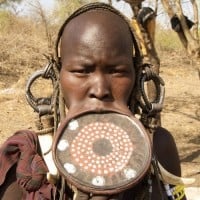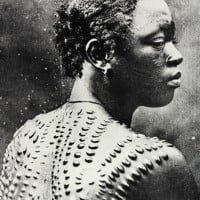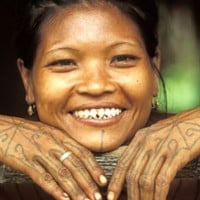Top 10 Unusual Beauty Standards in the World
Beauty is normal in our lives. We have our own fashions and ways to be stunning. Everyone has a definition of beauty. Most of us define beauty by make up, fashion and being fit. Sometimes, we need to spend money just to beautify ourselves. Some of us want to be a model so we need to do something just to look appealing. However, in some cultures they have their own definition of beauty and maybe it is not familiar to us what is their own beauty. So in this list, we will learn about the different and unusual forms of beauty standards from all over the world. It may look unusual for others but that's the symbol of beauty for those certain cultures.Take Note: We need to respect all the forms of beauty.
Let's begin.

Lotus feet or foot binding is a tradition from the country of China where the young girls break and bind their feet to make it smaller and change its shape. It is a part of Chinese tradition that foot binding represents beauty and the smaller foot represents the empress' foot. The custom made shoes that women with lotus feet wearing called lotus shoes. It is a main practice that became popular among the higher class during the Song Dynasty and lower class during the Qing Dynasty. However, this kind of practice is painful since it will deform your bones and shoes. So nowadays, foot binding has been banned. So, only the old women have this practice.

In the Mursi people in Ethiopia, young women will put a lip plate six months before their marriage. They start to get piercings at the age of 15 or 16. Their lips will be cut by the woman as a sign of their bravery and perseverance. The larger the lip plate is, the braver the woman is. It is a form of beauty since lip plates tends to attract a husband. Also, lip plates symbolizes beauty and bravery. When a Mursi woman doesn't have lip plates, it depicts laziness. Also, having a lip plate automatically counts a person as a member of the tribe.

Among the Kayan women in Northern Thailand and the border of Myanmar, elongating their necks and adding brass rings symbolizes beauty. The brass neck rings called "Padaung". It starts at the age of five. They add rings to make a neck much longer. After, they add more rings every two years to make it much more longer. The longer the neck is, the more beautiful the woman is. That's the belief of the Kayan people. There's is no actual explanation about this tradition. Even the Kayan women themselves didn't know it. Some people say that longer necks serves as a protection for a woman from tiger attacks or kidnapping from the rival tribes. In today's era, they do this just because it preserves their culture.


Crooked teeth may look like vampires to us, but in Japan, this kind of teeth symbolizes beauty. It is called Yaeba in Japanese. Japanese people find it attractive especially for the girls. It is symbolizes the sexual attractiveness of a woman. So, Japanese women go to the dental clinics just for the fake crooked teeth.

Did you know that being a fat people is just a symbol of beauty in Mauritania. Yes, being fat in Mauritania is the form of beauty. Being a bigger person means being more beautiful. It is normal in this country for having a big women. That's their own beauty. The term used in this kind of practice is called "lebbouh". So to do that practice, they encourage the young girls to eat more and more foods to gain weight. They start this practice at the age of 5. They are required to eat at least 16,000 calories of food every day. The bigger the woman is, the more fortune it comes. For the process, the girls are sent to fat camps to eat more food. If they fail, they will be tortured and embarrassed.

Scarification is a form of body modification in which the skin cuts by the several sharp objects such as knifea, chisels, blades and others just to leave the scar. In Africa, scarification is a form of beauty. Having a scar makes you attractive. The scar may vary depending to the certain type, and size and a personal positions.

In West Sumatra, Indonesia, the Mentawai people sharpen their teeth with chisel. They practice it without any anesthesia which is painful. The main purpose of this modification is being an aid to finding a partner. Also, it is a symbolism of beauty in the inner spirit.

The Maasai people in Kenya stretched their earlobes just to depict beauty. It also symbolizes the social status. They stretch their earlobes by putting larger and larger objects until it become stretched. In Indonesia, The Dayak people do the same practice in the older generations. They start it at the infancy by making a pierce by the ballast in the form of rings. After, more rings will be added and added and added as soon as they grow order. It also symbolizes patience. However, this kind of practice is actually rare among Dayak people.

That picture though. It's terrifying...

In Japan, the women turning their teeth black. It is called Ohaguro. It is a tradition where the person blackens the teeth by the solution called kanemitsu. It is the solution of vinegar and iron filings as well as vegetable and tea tannins. They started practicing it at the age of fifteen as they are beginning to reach adulthood. This practice prevents tooth decay which makes them more beautiful. However, this type of custom is now banned since the Meiji Government.

Iran has the world's highest rate of nose surgery. It is a big trend in that country. Iran was already influenced by the Western stuff so the traditional ethnic Persian nose is out of fashion.